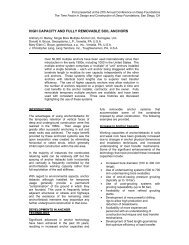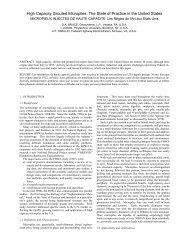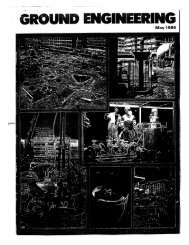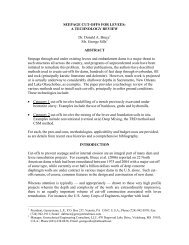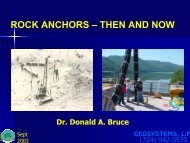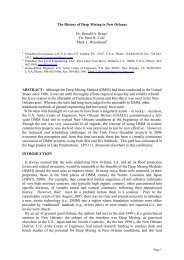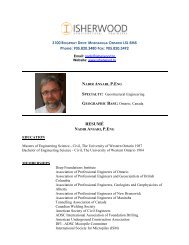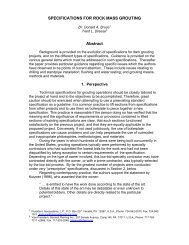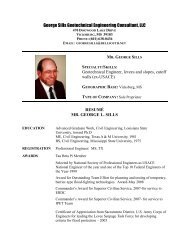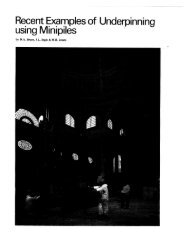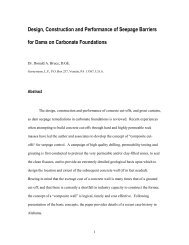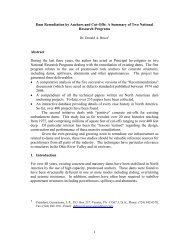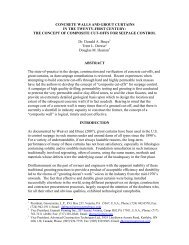miniJET : A New Type of Micropile - Geosystems, LP
miniJET : A New Type of Micropile - Geosystems, LP
miniJET : A New Type of Micropile - Geosystems, LP
Create successful ePaper yourself
Turn your PDF publications into a flip-book with our unique Google optimized e-Paper software.
This paper describes a new variant <strong>of</strong> the <strong>Type</strong> E pile, wherein the advantages <strong>of</strong> jet grouting<br />
technology are exploited to significantly increase the effective diameter <strong>of</strong> the pile as the bar is<br />
jetted into the soil, and to provide superior grout/soil skin friction potential. This development<br />
has been named by Layne GeoConstruction as <strong>miniJET</strong> ® .<br />
2.0 SYSTEM DESCRIPTION<br />
Many foundation remediations feature the construction <strong>of</strong> a jet grouted block which, depending<br />
on the structural loading requirements, may require steel reinforcement to help resist lateral<br />
and/or vertical stresses. Such steel reinforcements have traditionally been installed in holes<br />
drilled through the jet grouted block after it has reached a certain strength, and so <strong>of</strong>ten many<br />
days after the jet grouting has been completed. The time needed to sequence and conduct this<br />
reinforcement process can markedly impact the progress <strong>of</strong> such projects, especially when they<br />
involve restricted access such as in industrial facilities.<br />
In contrast, <strong>miniJET</strong> ® permits the jet grouting to be conducted and the columns to be internally<br />
reinforced in one operation. Figure 2 shows the components <strong>of</strong> the system, which are<br />
principally:<br />
<br />
<br />
<br />
Sacrificial drill bit with two or more nozzles to permit the grout to be ejected laterally (to jet<br />
grout the soil) and downwards (to facilitate penetration <strong>of</strong> the system). These drill bits can<br />
be modified as appropriate to match the site-specific soil conditions.<br />
Hollow, continuously-threaded steel bars <strong>of</strong> outside diameters 32-76 mm (Table 1). These<br />
can be provided in lengths <strong>of</strong> 1 to 6 m depending on specific project conditions.<br />
Steel couplers with special high pressure seals to prevent escape <strong>of</strong> grout during jetting.<br />
These components are shown in Photograph 1. Photograph 2 shows a variation suitable for use<br />
as a permanent prestressed anchor (also patented). In this variant the bar is galvanized and<br />
protected/debonded over its free length by a polyethylene sheath. Regarding the installation<br />
equipment, the drilling rig is equipped with a special swivel at the drillhead while, in order to<br />
enhance the control and quality <strong>of</strong> the operation, automated drilling and grouting parameter<br />
instrumentation is provided in the drill rig. These data are relayed telemetrically in real time to<br />
the project’s site <strong>of</strong>fice, as are the grouting data from the grout station. The grout station is<br />
typical <strong>of</strong> a conventional jet grouting installation, comprising an automated colloidal mixer,<br />
Tecniwell TWM20 or similar, which weigh batches bulk materials, an agitated storage tank, and<br />
a jet grouting pump, Tecniwell TW400 or similar.<br />
3.0 CASE HISTORY<br />
3.1 Background<br />
Modifications to an existing industrial facility in Florida required extensive jet grouting to<br />
provide support for a number <strong>of</strong> excavations, and to provide deep foundations for support <strong>of</strong> a<br />
new structure. Due to the design requirement to provide significant tensile and lateral capacity,<br />
the jet grouted mass required internal, vertical reinforcement in many areas.<br />
2



